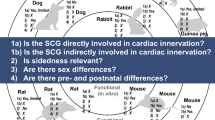Abstract
Cardiac sympathetic denervation for intractable angina pectoris in patients unsuitable for conventional revascularization is currently gaining popularity since this procedure may be performed via minimally invasive surgery. A thorough understanding of cardiac innervation and its variations is crucial to successfully effect cardiac denervation. This study aimed to demonstrate the cervical and thoracic sympathetic contributions to the cardiac plexus. The cervical and thoracic sympathetic trunks in 21 fetuses and eight adults were micro-dissected bilaterally and documented (n=58 sides). The superior cervical cardiac ramus originated from the superior cervical ganglion (present in all specimens) in 53% of cases. The middle cervical ganglion (incidence 81%) gave rise to the middle cervical cardiac ramus in 88% of cases. The cervico-thoracic ganglion (incidence 85%) gave the cervico-thoracic cardiac ramus in 84%. In the thoracic region, four cardiac rami arose from the T2–T6 segment of the thoracic sympathetic trunk. All cervical and thoracic cardiac rami were traced consistently to the deep cardiac plexus. Khogali et al.'s (1999) success of limited T2–T4 sympathectomy in relieving pain at rest of patients with intractable angina pectoris appears to indicate that a significant afferent pain pathway from the heart is selectively interrupted. The variability in pattern of the cervical ganglia, cardiac rami and cervical contributions to the cardiac plexus does not appear to affect the outcome of limited sympathectomy. The complexity of cardiac pain pathways is not fully understood. The study is continuing and attempts to contribute to defining these cardiac neuronal pathways.
Résumé
La dénervation sympathique cardiaque pour angine de poitrine réfractaire chez les patients ne pouvant bénéficier d'une revascularisation conventionnelle est en train de connaître un regain de popularité depuis que cette technique peut être réalisée en chirurgie minimalement invasive. Une compréhension approfondie de l'innervation cardiaque et de ses variations est cruciale pour réaliser une dénervation cardiaque réussie. Cette étude avait pour but de démontrer les contributions sympathiques cervicale et thoracique au plexus cardiaque. Une microdissection bilatérale des troncs sympathiques cervico-thoraciques de 21 fœtus et de 8 adultes a été réalisée sous microscope et documentée (n=58 côtés). Le rameau cardiaque cervical supérieur naissait du ganglion cervical supérieur (présent dans tous les cas) dans 53% des cas. Le ganglion cervical moyen (présent dans 81%) donnait naissance au rameau cardiaque cervical moyen dans 88% des cas. Le ganglion cervico-thoracique (fréquence 85%) donnait naissance au rameau cardiaque cervico-thoracique dans 84% des cas. Dans la région thoracique, 4 rameaux cardiaques naissaient du segment T2–T6 du tronc sympathique cervical. Tous les rameaux cardiaques cervicaux et thoraciques étaient suivis jusqu'au plexus cardiaque profond. Les succès enregistrés par Khogali et al. avec une sympathectomie limitée à T2–T4 pour la sédation de la douleur au repos des patients présentant une angine de poitrine réfractaire, semblent indiquer qu'une importante voie afférente de la douleur du cœur est interrompue de façon sélective. La variabilité dans l'organisation des ganglions cervicaux, des rameaux cardiaques et des contributions du plexus cervical au plexus cardiaque ne semble pas avoir d'impact sur le résultat de la sympathectomie limitée. La complexité des voies de la douleur cardiaque n'est pas complètement comprise. L'étude est à poursuivre et vise à contribuer à définir les voies nerveuses du cœur.





Similar content being viewed by others
References
Claes G, Gothberg G, Drott C (1993) Endoscopic electrocautery of the thoracic sympathetic chain: a minimally invasive method to treat hyperhidrosis. Scand J Plast Reconstr Hand Surg 27: 29–33
Ellison JP, Williams TP (1969) Sympathetic nerve pathways to the human heart, and their variations. Am J Anat 124: 149–162
Groen GJ, Baljet B, Boekelaar AB, Drukker J (1987) Branches of the thoracic sympathetic trunk in the human foetus. Anat Embryol 176: 401–411
Khogali SS, Miller M, Rajesh PB, Murray RG, Beattie JM (1999) Video-assisted thoracoscopic sympathectomy for severe intractable angina. Eur J Cardiovasc Surg 16: 595–598
Kuntz A, Morehouse A (1930) Thoracic sympathetic cardiac nerves in man. Arch Surg 20: 607–613
Mitchell GAG (1956) Cardiovascular innervation. Livingstone, Edinburgh, pp 196–225
Mizeres NJ (1972) The cardiac plexus in man. Am J Anat 112: 141–151
Perman E (1924) Anatomische Untersuchungen über die Herznerven bei den höheren Saugetieren und beim Menschen. Z Anat Entweg 71: 382–457
Pick J (1957) The identification of sympathetic segments. Ann Surg 145: 355–364
Ross JP (1958) Surgery of the sympathetic nervous system. Tindall & Cox, Bailliere, pp 154–160
Wettervik C, Claes G, Drott C, Emanuelsson H, Lomsky M, Radberg G, Tygesen H (1995) Endoscopic transthoracic sympathectomy for severe angina. Lancet 345: 97–98
White JC, Smithwick RH (1942) The autonomic nervous system. Kimpton, London, pp 275–306
Author information
Authors and Affiliations
Corresponding author
Electronic Supplementary Material
Rights and permissions
About this article
Cite this article
Pather, N., Partab, P., Singh, B. et al. The sympathetic contributions to the cardiac plexus. Surg Radiol Anat 25, 210–215 (2003). https://doi.org/10.1007/s00276-003-0113-2
Received:
Accepted:
Published:
Issue Date:
DOI: https://doi.org/10.1007/s00276-003-0113-2




